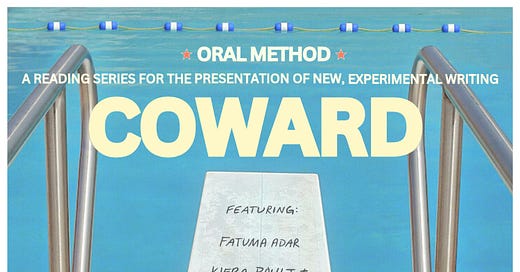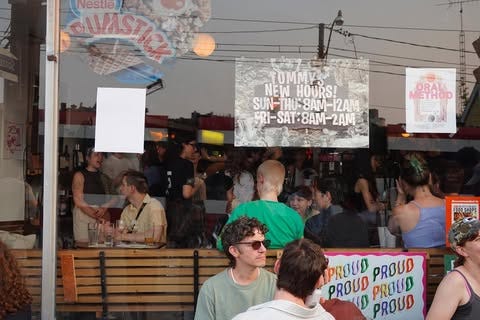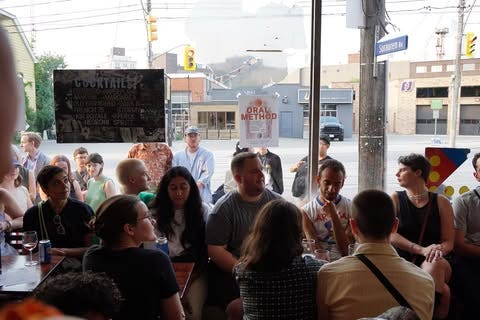Maker's Mark: Esmé Hogeveen
The Juncture talks to writer and organizer of the reading series, Oral Method
Welcome to Maker’s Mark, where The Juncture talks to local makers and artists about their work and their communities. For this edition, Luke talks to friend of TYPE Junction, Esmé Hogeveen, who organizes Oral Method, a reading series that invites writers and artists to create new work in response to a theme-based prompt with the intent of reading the resulting texts aloud for the first time in the presence of other readers and listeners.
The Juncture strongly encourages you all to attend Oral Method’s next event which takes place tonight, Friday June 20 at 7:30 at Factory Theatre.
Luke: I’m curious about your impetus for starting Oral Method. I remember the first one, which happened at Tommy’s Wine Bar and there was literally a line out the door. People were piled outside, there was so much excitement. It felt quite electric being there.
Esmé: That was wild.
L: What was the inspiration to start?
E: I moved back to Toronto from Montreal in 2020, and for the next couple years my mom was really sick and it was the pandemic, so it was a hard time for everyone. I was grateful to be in touch with friends again, but I didn’t really feel like I had reconnected with the city. Around 2022, I started hearing about readings and literary projects popping up, with events happening outdoors or being tentatively scheduled. It was the era of “this might happen, but we’ll have to see”.
I interviewed Whitney Mallett last year about The Whitney Review and she was talking about the rise of post-pandemic reading events and we wondered if it’s partly because lit events were relatively cheap to organize. Is it a coincidence that readings took off towards the end of the pandemic? I think people appreciated the IRL connection too. Overall it’s a lot of work to organize Oral Method, but there’s something inherently flexible about the format.
For several years, I observed cool writing projects happening in other cities and wondered: do I need to go there? Do I need to live in London or LA to access these things? But then I thought maybe I should just try to start something here and see how it goes. I knew there were a lot of great writers in Toronto, some of whom hadn’t presented their work publicly in a long time. For the first event on the solstice in June 2023, I invited a mixture of writers I knew personally or had admired from afar. Very luckily everyone was down to participate, which was extra kind because Oral Method was very much a DIY no money project, especially at the beginning.
L: There are some other reading series in the city that come to mind. Pack Animal is one, and last week we were both at Natural Born Sinners. I feel like the ones I can think of all started at a similar time. It didn’t feel like there was that energy happening before, so it feels like a fresh thing.
E: That’s a good point—there’s been an eruption of readings in the past few years, which I’m so grateful for.
The idea for Oral Method was simmering for a while. I had the name and the concept of inviting writers working across different genres to respond to a shared prompt and read new work aloud. A couple years ago, I told my friend Kara Hamilton about it and she asked if I was interested in developing an Oral Method program as part of a bigger art project she was working on. Kara’s invitation compelled me to take the idea more seriously—I had to write up a project description and had to ask myself, ok, what is the format? What are the goals?
And of course, I was inspired by other great reading series happening in Toronto. You mentioned Pack Animal already, but I think they need a special shoutout because they’ve really rejuvenated a sense of literary jouissance in the west end. I wanted to extend that energy and hopefully contribute another context for writers to present new work. There are all these writers with different experiences, interests, genres, and personal taste. I thought, what’s something different I can add into the mix? Coming out of the pandemic and appreciating the IRL connection piece made me think, wouldn’t it be fun to ask people to write something with the intent of reading it out loud for the first time? I wanted to push writers to really consider orality—and aurality—and to write in anticipation of sharing in real time with other people.
L: I also think one of the qualities that is interesting is the nomadic nature of Oral Method. Many of them have been at different locations, but the last one even being in a different city, in Montreal. How did that feel?
E: Yes, the last Oral Method event was at Star Bar in Montréal, and it was so fun! I love that it’s become a project that happens in different places and with different collaborators. The upcoming event “Coward” is happening at the Factory Theatre on June 20th and I’m co-organizing it with Kalale Dalton-Lutale, who is a previous Oral Method reader. Kalale and I originally met through a Trampoline Hall reading curated by your colleague Cason Sharpe. It’s a small world and yet I wouldn’t have met so many of these writers if it wasn’t for lit activities.
I didn’t set out for Oral Method to be social per se, but it’s been such a fun way to meet writers and to make friends and art together in a relatively low stress way. The Montréal event was the first outside of Toronto and it felt great to co-organize with Rosemary Flutur, who was a reader at the very first event at Tommy’s Wine Bar. I don’t think I have a particular philosophy, but it’s nice to keep testing the format and seeing what different writers and artists want or need from the project, how it can serve them and their practices. I was excited to organize an event another city and I hope Oral Method can go other places, too.
L: And different types of venues too. This one being the first in a theatre! And since you mentioned it too, some of my colleagues have been involved. Cason has been a past reader as well, and I know you have been in a reading group with Jessica, Max and Cason. And Jessica is an upcoming Oral Method reader!
E: Yes, Jessica has been on a list of writers I admire for ages, but we didn’t meet properly until this winter when we participated in a “Bad Behaviour”-themed reading group that Cason organized with Adrienne Scott at Art Metropole. I’m really excited to hear what Jessica reads.
L: You aren’t privy to what writers will read before the event, right?
E: Yeah, so we share a prompt with the writers and artists—each event includes one artist also responding to the prompt—about 6 weeks before the event and they all create something new to read aloud or share for the first time at the event. My hope is that the short amount of time encourages participants to experiment, perhaps trying something outside of their regular form or genre. For example, a novelist might write a poem, a journalist might write a letter to uncle, a podcaster might write a personal essay.
I keep the writing window short so people don’t feel pressured to produce something super polished. Toronto has such a strong drive towards professionalization that I think it’s easy to get locked into dialogue or exchange with people who have a very similar practice, aesthetic, philosophy, or professional level. By giving writers and artists a shared prompt and a succinct timeline, I hope to provide space for messiness and playfulness. I don’t mean “messy” as in creating something bad or half-baked, but in terms of trying something new and experiencing live feedback through reading in front of a roomful of people.
Part of me wants to push against Toronto’s hyper-professionalizing instinct. There’s so much pressure in writing, and in the arts in general, to lock into one groove and rep a super-coherent brand. Readings often feature writers reading from a pre-published manuscript, which is great and obviously important. With Oral Method, though, I wanted to find a space between an open mic and something that is still curated and intentional.
To answer your question though, since it’s such a short amount of writing time, the writers don’t have to submit a draft and I never know what people are going to read. I understand that Jessica’s piece will include reflections on some of the texts she brought to our reading group, including work by Christina Sharpe, Hilton Als, Hanif Abdurraqib, and the movie Sinners. I’m curious how she will connect those texts through the lens of cowardice.
L: Oh, interesting! And who is the artist this time around?
E: The artist is the amazing Eunice Luk. She’s an artist-publisher who runs Slow Editions, and I’ve admired her ceramics, textile, sculpture, and book work for years. Eunice and I have been in touch for the past couple weeks about the “critter feet” she will be installing either on or near the stage during the reading. You will have to come to the event to learn more about what a “critter foot” is, but it’s been so fun to see how different practices interpret the prompt. And it’s my very humble hope that having one extra-textual artist contribution per event helps connect literary and art audiences. Writers often contribute texts to art exhibitions, and I like to think of Oral Method as exploring the inverse!
L: For sure! We carry some Slow Editions publications, some really lovely books. And Jessica is a wonderful writer, So I’m always so intrigued to hear what books she has been reading and what she is thinking about. You do have quite a few connections to the Junction Type location with these friendships, but you’re also a beloved customer and patron. I wonder about your bookstore habits and reading practice, how has that informed Oral Method?
E: What a nice question, and that’s so kind! I grew up between Bloor West Village and the Junction, so I’m happy there’s a TYPE in the neighbourhood. In terms of my personal reading practice, I’m embracing becoming a generalist. I have an academic background studying English and critical theory, and I’ve done a lot of art writing, so those interests inform my reading choices. I’m always trying to strike a balance between reading contemporary literary—both fiction and nonfiction—and catching up on the classics, whether niche or mainstream. For instance, I just bought Edna O’Brien’s The Country Girls from an amazing used bookstore called Pilgrim Reader Books in Combermere, Ontario, last weekend. I’ve been meaning to read it for years and it’s finally my O’Brien summer.
I’m very influenced by friends and their recommendations, whether that’s online or in person, but also by impulse and instinct. I love to go to a bookstore, and I also just renewed my library card. I feel like it’s easy to get kind of trapped in a particular reading lane, like if you’re a woman in your thirties you could exclusively read books about women in their thirties introspecting about sessional arts teaching, environmental collapse, the Internet, and depression. And I like those topics, but I also want to read about other things. How do you and your colleagues encounter the books you want to read?
L: I certainly always like looking at the staff picks wall. It’s sort of always in flux, but there are some certain mainstays that my colleagues love and stand by. It’s nice to see this mosaic of what makes the store tick and see the reading habits of my, I’d say, quite brilliant colleagues. Whenever I’m at work, one of the first questions we ask each other is “what are you reading these days?” So, to ask you the same: What are you reading these days?
E: I’m currently reading a galley of Happiness and Love by Zoe Dubno, which Emma Cohen [co-organizer of Pack Animal] lent me. I’m also reading Back in the Land of the Living by Eva Crocker, who was one of the Montréal Oral Method readers, and I just ordered—from the Junction TYPE actually—Valérie Bah’s new book, Subterrane, which just won the Amazon Canada First Novel Award. I also recently resubscribed to the print New Yorker, which is a constant delight and source of guilt. I’m trying to keep up my print reading this summer! What are you reading right now, Luke?
L: One of my favourite recent reads was Madonna in a Fur Coat by Sabahattin Ali. It’s a really beautiful and quite interesting novel, set in Weimar Berlin through the perspective of a young Turkish man. He goes to Germany for his father’s business and becomes captivated by this portrait of a woman at an art gallery, and then falls in love with the woman who painted it. It’s extremely melancholic and full of yearning. It was written in the 1940’s, but it’s a mainstay in Turkish literature, a strange classic which got translated into English for the first time a decade ago and has now had this big resurgence in popularity of recent. It’s my staff pick, so it’s on the wall! I’m also reading Nicola Dinan’s Disappoint Me, which is great. A good queer London novel. And Brontez Purnell’s 100 Boyfriends. For Pride, I suppose.
E: I want to read that Turkish book. It sounds awesome.
L: Come in! We’ll get you a copy. Any other information in anticipation of the reading on Friday?
E: It’s free and doors are at 7:30pm with readings at 8pm. Seating is limited, so come early! And we're going to be inviting folks to donate, in lieu of a ticket, to Davenport Aid Brigade, which is an amazing mutual aid group delivering humanitarian aid to displaced Palestinian families in Gaza and Cairo.











